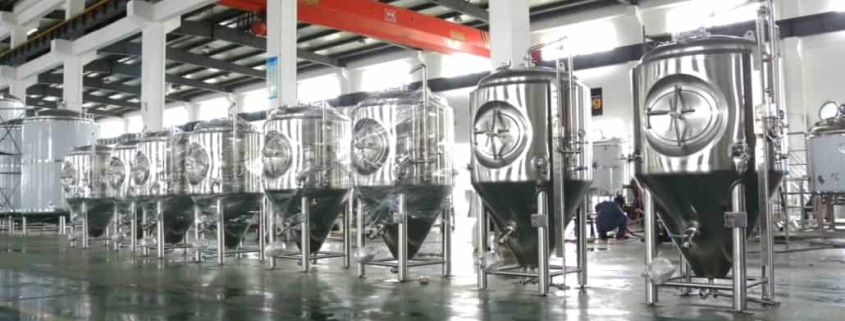10 BBL Stacking Lager Tanks
10 BBL Stacking Lager Tanks are stainless steel fermenters used by craft breweries to ferment and condition lager beer. 10 BBL refers to a volume capacity of 10 barrels, which equals 310 gallons or 1,173 liters. Stackable tank designs allow fitting more fermentation vessels in limited brewhouse footprints by stacking tanks vertically.
Lager tanks feature jacketed stainless steel vessels with glycol cooling to precisely control fermentation temperatures. They come equipped with ports, valves, sight glasses, stands, stairs, and other accessories for cleaning, filling, monitoring, and moving beer between tanks.
This guide covers different 10 BBL lager tank types, sizing considerations, customization options, top suppliers, installation, maintenance, and selection criteria when upgrading a brewhouse.
Types of 10 BBL Stacking Lager Tanks
| Tank Type | Description |
|---|---|
| Cylindrical | Most common, horizontal orientation, efficient glycol jackets |
| Conical | Sloped bottom with cone base, easier yeast removal |
| Hybrid UniTanks | Combined fermenter and brite tank |
| Open Fermenters | Shallow tanks with more surface area |
10 BBL Lager Tank Sizing
Key factors driving 10 BBL tank sizing:
- Batch sizes and production goals
- Available floorspace and ceiling height
- Budget
- Existing infrastructure limitations
Standard dimensions can range from:
- 5′ diameter x 12′ height
- 6′ diameter x 10′ height
- 8′ diameter x 8′ height
Customization Options
Tanks can be customized by:
- Material (100% stainless or stainless interior plus steel jacket)
- Number and size of ports
- Placement and size of cooling jackets
- Stand, stair, and walkway configurations
- Levels of automation
Work with tank manufacturers early in planning stages to spec tanks appropriately.
Top 10 BBL Stacking Lager Tanks Manufacturers
| Supplier | Price Range | Lead Times |
|---|---|---|
| JV Northwest | $$ | 12-16 weeks |
| AAA | $ | 16-20 weeks |
| Stout Tanks | $$$ | 12-18 weeks |
| Premier Stainless | $$ | 10-14 weeks |
| SS Brewtech | $$$ | 8-12 weeks |
$$$ = Premium $$ = Mid-range $ = Budget *Pricing and leads vary depending on customization and order sizes
Installation, Operation and Maintenance
Proper tank installation is critical for safety, performance, and longevity. Work with an experienced contractor and follow manufacturer guidelines.
Operation procedures will specify filling volumes, fermentation schedules, cleaning protocols, and transfer methods tailored to your recipes and yeast handling. Staff training is essential.
Maintenance requires routinely inspecting and replacing gaskets, fittings, seals and cooling system components like hoses and valves. Tanks should be passivated after installation and periodically thereafter.
How to Select the Best Lager Tank Supplier
Criteria for selecting the ideal lager tank partner:
| Consideration | Details |
|---|---|
| Reputation & Experience | Years providing quality tanks suiting craft brewhouse needs |
| Customization Capabilities | Can modify tank designs and accessories to suit individual recipes, space, budgets |
| Quality & Lead Times | Constructed of high grade stainless steel with quick, reliable delivery |
| Local Support Network | Has distributors and technicians to assist with install and maintenance |
| Price | Competitive pricing fitting small brewery budgets |
Get quotes from multiple vendors early. Lean on industry connections for referrals to reputable tank suppliers.
Comparison of 10 BBL Stacking Lager Tanks
| Parameter | Cylindrical | Conical | UniTanks | Open Tops |
|---|---|---|---|---|
| Ease of Installation | High | Medium | Medium | High |
| Glycol Jacket Efficiency | High | Medium | Medium | Low |
| Yeast Handling | Difficult | Easy | Medium | Difficult |
| Hop Separation | Difficult | Easy | Easy | Medium |
| Maintenance Needs | Low | Medium | High | High |
| Capital Costs | $ | $$ | $$$ | $ |
Advantages: Efficient glycol jackets, compact footprint, lower price points Limitations: Tight fits for dry hopping, difficult yeast removal
FAQ
What are the price ranges for 10 BBL stacking lager tanks?
- $15,000 to $30,000 for basic cylindrical fermenters
- $25,000 to $50,000 for conical and hybrid tanks
- Budget at least $100 to $150 per gallon capacity
What facility requirements are needed for tank installs?
Tanks need open floorspace, sufficient ceiling height and door/wall clearance to maneuver tanks into position, reinforced mezzanines or floors if stacking, glycol system connections, and drains meeting local wastewater codes.
Is used brewing equipment an option?
Absolutely. Buying quality used tanks can reduce costs substantially. Ensure tanks have many years of service left and get formal inspections before purchasing.




